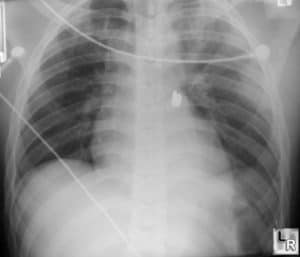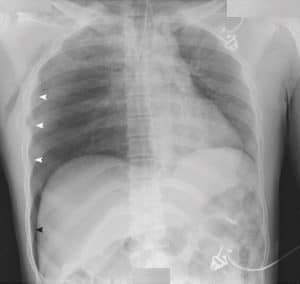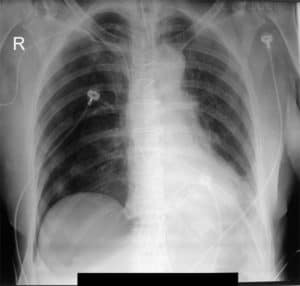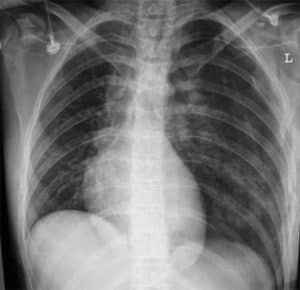 Have you ever had a chest X-ray in someone that might have a pneumothorax, but you couldn’t see it? I know I have. Today I wanted to mention three signs that might help:
Have you ever had a chest X-ray in someone that might have a pneumothorax, but you couldn’t see it? I know I have. Today I wanted to mention three signs that might help:
The first is the Deep Sulcus Sign. This is the more widely known. The other two signs are the Etched Diaphragm and the Etched Mediastinum.
The DEEP SULCUS SIGN may help. It is simply a lucent deep costophrenic angle, that occurs in supine chest x-rays due to the lateral accumulation of air. Even if you can’t see a pneumothorax, if the story is good and there is a deep sulcus sign, you need to assume one is present. In this image above from learningradiology.com, the deep sulcus sign is on the patient’s left. Notice the normal hemi-diaphragm on the other side.
In this image below from the NEJM, even thought the right sided pneumothorax is difficult to see (shown by white arrows), the deep sulcus sign on that right side gives it away.
 The Second Sign is the ETCHED DIAPHRAGM. This refers to cases where the diaphragm is highly contrasted in respected to the lung. Look at the X-ray below from wikiRadiography. The right hemi-diaphragm is highly contrasted, i.e. sharper, than the left. There is a right pneumothorax here and a deep sulcus sign.
The Second Sign is the ETCHED DIAPHRAGM. This refers to cases where the diaphragm is highly contrasted in respected to the lung. Look at the X-ray below from wikiRadiography. The right hemi-diaphragm is highly contrasted, i.e. sharper, than the left. There is a right pneumothorax here and a deep sulcus sign. The ETCHED MEDIASTINUM is similar to the etched diaphragm and looks at the contrast between the heart border and the lung. I must admit that I find this the hardest as I always seem to see it. In the image below from wikiRadiography, the left pneumothorax is visible, but also notice the increased contrast over the left heart border and the left sided deep sulcus sign.
The ETCHED MEDIASTINUM is similar to the etched diaphragm and looks at the contrast between the heart border and the lung. I must admit that I find this the hardest as I always seem to see it. In the image below from wikiRadiography, the left pneumothorax is visible, but also notice the increased contrast over the left heart border and the left sided deep sulcus sign. I suppose that in conclusion I would have to say that the DEEP SULCUS SIGN is the most useful of the signs. Look for it in the supine chest X-ray.Peter Kas
I suppose that in conclusion I would have to say that the DEEP SULCUS SIGN is the most useful of the signs. Look for it in the supine chest X-ray.Peter Kas










